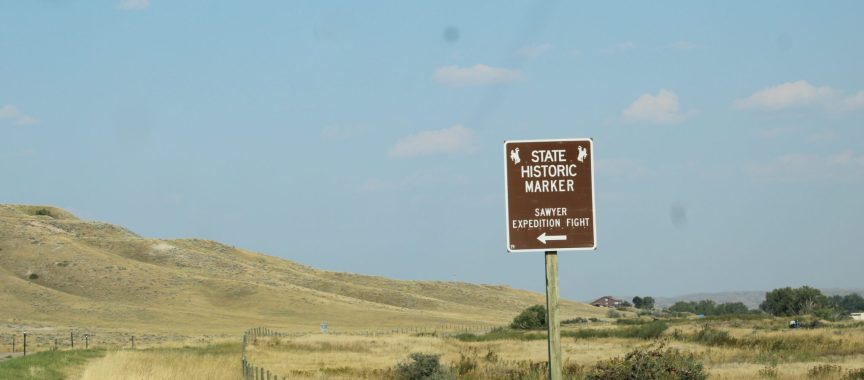News – Sheridan Media

Not far from Sheridan, between Ranchester and Dayton, is a small sign along highway 14 reads, “The Sawyers Expedition Fight,” with an arrow pointing to the north side of the highway. The battle was a part of the Sawyers Expedition, which was undertaken in 1865 to improve the emigrant trails to Montana. The battle happened when the train was attacked by a group of Arapaho warriors retaliating against Crook’s attack on their village which became known as the Battle of the Tongue River.

Here is a brief look at his expedition, and the battle.
This from the Buffalo Bulletin, Thursday, June 16, 1921 –Sawyer Expedition – The Sawyer Road party left the mouth of the Niobrara River, Nebraska Territory, on the 13th day of June, 1865 and was in charge of Col. J. A. Sawyer, of Sioux City, lowa. Colonel Sawyer had been an officer in the Civil War and was an engineer of considerable experience, and was considered a competent man for the enterprise.
His working force consisted of about a hundred men and he had fifty-two teams of oxen. His military escort consisted of Companies C and D., and the Fifth U. S. Volunteers, and twenty four men under Captain Geo. W. Williford. They were also provided with two pieces of artillery.
The route led them west along the Niobrara River for about two hundred and fifty miles, when they crossed to the Southern Cheyenne River, up which stream they traveled to the mouth of Black Thunder Creek.
Following that river on to its head they crossed the Belle Fouche River, and from there headed in a northwesterly direction for Powder River; their object in going in that direction being to find a suitable crossing on the Powder lower down than the Bozeman trail crossing at Fort Connor, (later named Fort Reno, near present-day Kaycee) and thus shortening the route.
From official reports it seems that Connor had sent word to Sawyer not to attempt to go in that direction; the guides with Connor contending that the route was not feasible; but it was not until he found the rough and broken country impassable for his train that he turned back, intending to retrace his steps to the Belle Fouche, from where he intended to turn south and take the crossing higher up.
The Indians in the mean time had been closely watching the expedition and on the second days’ journey back to the Belle Fouche the train was attacked by a large number of the Indians being Sioux under Red Cloud and Cheyennes under Dull Knife, who kept the train corralled for four days and nights. Of this engagement Captain Williford in his report says: “Fighting through the day; and at night the enemy would withdraw to commence the fight again at early dawn, but finding that every effort to capture a train and kill its defenders only resulted in their loss and many killed and wounded braves, they abandoned the siege.
According to General Dodge, however, after the failure of the attack they held a parley. George and Joe Bent, (half-Cheyenne sons of Charlie William Bent, mountain man and stage stop owner) appearing on behalf of the Indians; and Colonel Sawyer gave them a wagon load of goods to let them proceed through the Indian country without further molestation.
Captain Williford was not in favor of Sawyer’s proposition and protested against the giving of the goods to the Indians; and subsequent events showed that he was right, as the next day the Indians again attacked the train as they were proceeding on their way to the Belle Fouche. In the attack the Indians were again repulsed and did not again molest the party.
Captain Williford reported that he lost three men in the engagements, Privates Orlando Sous and Anthony Nelson, Troop B, First Dakota Cavalry, and Nat Hedges, citizen and sutler for the expedition and that only a few were wounded and those slightly. The train then proceeded south to South Butte, near which they camped while Captain Williford with a detachment of the cavalry made a reconnaissance; finding they were within thirteen miles of the road constructed by General Connor and only a days march to the newly constructed Fort Connor.
They arrived at Fort Connor on August 24, and Captian Williford and the U.S. Volunteers were relieved from escort duty and ordered to garrison the fort; a detachment of the Sixth Michigan Cavalry under Captain Cole being sent with Sawyer. General Dodge is authority for the statement that as far as road-making was concerned, the Sawyer Expedition was a failure, that private outfits joining the party swelled the train to about 80 wagons, and more attention was paid to getting the train through than to survey and construct roads. That Captain Williford went simply as an escort to the party, and had no control whatever over it, and exercised none until he was obliged to do so in order to save his command, in which, by his superior ability and skillful management, he succeeded.
From Fort Connor the expedition proceeded unmolested until they reached the Tongue River, where they were again attacked, presumably by the same Arapahoes that Connor had engaged, and they were again forced to corral the train. A courier dispatched to General Connor, the on the Tongue River, resulted in his sending Captain Brown with two troops of the California Cavalry to their relief; but the Indians had desisted in the attack before the arrival of the Brown forces and the next day the train resumed its journey. Captain Brown, however, accompanied them as far as the Big Horn River. In this engagement on Tongue River Captain Cole and two of his troopers were killed, the return of the Connor contingent to Fort Connor, on September 23, at last found the three columns united, but the deplorable condition of the Cole command made the continuance of the campaign out of the question.
This from a longer version of an article in The Sheridan Enterprise, August 6, 1912, from a narrative by A.M. Holman, who was one of the survivors of the expedition.

Many Camp Fires – We knew many Indian infected the country and so were guarded against any emergency which might happen and kept our arms ready for instant use. Upon descending into the Tongue River valley, we saw smoke from numerous campfires rising slowly from the trees and from indications there must have been a veritable horde of Indians. From our previous experience we knew they were not friendly. We trained our howitzer on a spot where the smoke was the thickest and sent a few shells flying into the camp. The result verified our suspicions for the Indians literally swarmed from the trees and underbrush. They were arrayed in warpaint with feathers, bells and animal skins for their garb. In a double column our train forded Tongue River, but this task was so arduous that by the time the last wagon was over the leading wagons were half a mile in the lead.
Forty head of loose oxen were bringing up the rear and were still in the water when the Indians, about 100 in number, and of the Arapahoe nation, swooped down on them and succeeded in cutting several off from the train. The wagon drivers couldn’t use their guns as their oxen required their entire attention.
We formed an irregular corral with our wagons and took the defensive against the Indians who by this time had been increased to about 600. They would ride in circles around our corral and shoot at us from under their horses’ necks. All were bareback and the way they yelled would shame the most ardent football rooters of our big colleges.
Short on Powder – The Indians were short of powder to that the force of the bullets was insufficient to inflict dangerous wounds. In fact, the marksman ship of the Indians was good, but their bullets didn’t hurt either the cattle or men. Had they used more powder and shot less, they would have done far better execution, and the list of fatalities would have been far more, even making it a doubt whether any of us would have escaped. The Indians swarmed the dense timber along the river and toward this point we decided to direct the heavy fire from our baby howitzer. We hauled the cannon to a commanding position and dropped a few shells into their midst. The Indians yelled with rage and we knew the cannon balls had done execution. The Indians did not retaliate but started building great fires and a barbecue of the stock captured from us was soon in progress. We thought the Indians would be appeased for the time being with their bellies full so we broke corral and in two columns entered the low hills beyond Tongue River. The Indians saw our move and attempted to frustrate it by riding ahead and firing upon us from the hills. We did not know how far it was to the next stream and rather than be cut off from a water supply we decided to go back to Tongue River.

Bullets Didn’t Hurt. – The Indians divined our motive and attempted to cut off our retreat. From there until we reached the river it was as pretty a skirmish fight as ever occurred, according to our military escort of 10 soldiers. The Indians attacked us from all sides but seemed to concentrate their strength on our rear. They poured volleys into the wagon train, but the bullets lacked force and many of them landed on the hides of the oxen with a thud but failed to even break the skin. We approached the river farther down than our first fording point. Twenty-five Indians circumvented the train and rode ahead to a vantage point along a high bank. We continued toward this bank in two columns with the bullets flying thick and fast, denoting a much superior force than first opposed us. James Dilliner, driving an oxen team in the lead, was killed by a bullet which struck him in the back, and in a few minutes E.G. Merrill, an emigrant of Sioux Falls, was also killed by a bullet while standing near the wheels of his wagon.
Both men were placed in one of the wagons and as no reserve driven was in the train, Dilliner’s wagon followed along without a guiding hand. For the fifth time since reaching Tongue River we made corral, but now we were out of rifle range.
This point was between Ranchester and Dayton, about the location of the old 76 ranch or to others known as the Bingham crossing. Here 10 canvas covered wagons were arranged in a large circle with all the oxen and cattle loose in the enclosure. The Indians were encamped one-fourth of a mile up the River. Both forces held these same postilions the second night and the prospect of avoiding a massacre at their bands seemed very slim indeed.
Go After Help. General Connor with his troops was 5O miles away on the Big Horn and that night Colonel Sawyer offered a liberal reward to any one who would volunteer to locate him and bring reinforcements. Three men with rations stealthily stole away that night on this perilous undertaking. There was no change of position of the Indians or our wagon train the third day. The weather had turned colder and a severe storm ensued. The Indians began leaving their camps in large numbers and retreated to the canyon. The stock waded around the enclosure in mud up to their knees and almost every man in the outfit was benumbed with cold.
The night of the third day, one of the drivers was restless while trying to sleep and he became much annoyed at a steer which kept rubbing its side against his wagon. He gave it a punch with a stick and started it on a frightened run. In return this steer startled others and in a few minutes all the animals had joined in the movement which by this time was a regular stampede. The darkness was intense and the noise of the bellowing animals quickened one’s heart. They broke through the wagons and went their way. Every man in the train had been sleeping on their arms that night and so all were up at the first commotion. It was the general impression that the Indians had stolen into the camp and had purposely stampeded the animals. Confusion reigned supreme for some time and dark figures were seen everywhere scurrying back and forth through the cold and clammy mud. Finally, the word was passed around explaining the cause of the commotion. Nobody followed the animals. We didn’t know where they had gone, and we didn’t care. We were all dejected in spirits, because of the cold and inclement weather and because we seemed doomed to destruction by the superior force of our enemy.
Indians Come Again – The next morning we found our cattle quietly grazing in the timber near the camp vacated by the Indians. They had fled before the storm and had sought a retreat in the Tongue River canyon. We built big fires, warmed ourselves, dried our clothing and then started westward again with our wagons. What was our dismay on getting several miles out to see the pesky varmints again riding down on us. We prepared for a defense but on their closer approach we discerned their white flags waving above their heads. They were flags of truce so we quietly let the chiefs of the tribe enter our camp without molestation. They wanted peace and in talking of the affair they explained their motive in attacking us. They thought we were soldiers and as the blue coats were known to be in the neighborhood against them they concluded we were but a party to the detachment.
Upon learning we were an emigrant outfit they decided to cease warfare upon us. While the seven chiefs were parleying in the camp, other Indians would stalk bravely into camp requesting a word with their chiefs. They tried to deceive us and the move was a fine piece of strategy on their part. At one time they did succeed in placing 27 armed men inside our corral and the other 300 braves were drawn up outside. They had planned to annihilate us with one blow-but couldn’t succeed in getting the proper number of men into our camp at one time.
Depose The Leader – Considerable objection had been made to Sawyer and much grumbling and complaint was heard against him in his treatment of the Indians. He was warned repeatedly not to let the warriors enter the camp but he only ignored these protestations. Finally an indignation meeting was held of everybody in the camp and with a majority vote of about 6O to 5, Sawyer was deposed. A successor was selected and the expedition abandoned the trip and headed back to Fort Connor.
The Sawyer Battle took place not far from Dayton, one of the many battles in our area as the Native Americans fought for their way of life against the emigrants and the gold seekers in the mid-1800s.
Last modified: September 8, 2025






